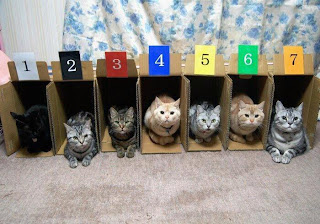Surprisingly, it is not well known that the Siamese breed of cat has
been around since before the sixteen hundreds and originated from
Thailand which at the time was known as Siam. These elegant cats were
introduced to cat fanciers of Great Britain in the eighteen hundreds
when the British Ambassador returned home with this lovely breed in tow.
It wasn't however until the nineteen fifties that the Siamese became a
very popular breed, although today they do not instill that same
popularity.
Just about everyone, whether a cat fancier or not has heard and
recognizes a Siamese cat. This is partially due to their popularity in
the mystery film genre. Many believe it is their curious nature that
makes them the perfect choice for a detective's assistant.
Appearance - The distinctive characteristics of a Siamese cat are
its long rectangular shaped body, a wedge shaped head, large ears, long
and elegantly thin legs, a long graceful tail and brilliant blue, almond
shaped eyes. The Siamese breed is a shorthaired cat and is available in
several different colors and patterns such as Seal Point, Chocolate
Point, Blue Point, or Lilac Point. All other color variations in this
breed are considered to be an entirely different breed altogether; the
Colorpoint Shorthair Breed.
Behavior and Characteristics - The Siamese breed is a loving,
playful, affectionate cat and requires owners who are home more often
than not to keep them company. Siamese cats that are bored or lonely
tend to find plenty of mischief to get into as well as possibly plotting
an escape route to the outside world.
However, if you are a career oriented person and still have your
heart set on owning a Siamese, you may want to consider adding a second
kitten to the home. This allows your Siamese not to be so lonely as well
as having a partner in crime. But don't worry; they will both be ready
and waiting to greet their owners at the door when they return home.
This breed of cat is particularly devoted to its family and is more
than willing to help with chores, keep you company as you move from room
to room or curl up in your lap for a nice relaxing evening. Siamese
cats are very outgoing and will meet and greet anyone who comes to the
door. Elderly people especially enjoy the loving and affectionate nature
of this elegant and beautiful breed. A highly intelligent breed, the
Siamese can be taught many tricks such as fetch and coming when their
name is called.
However, this breed does have a moody side and sometimes may decide
not to deliver a command performance when asked. In keeping with their
playful nature, the Siamese breed are also known for making up their own
games. Two of their most favorite playtime antics include hide and go
seek as well as plotting, planning and carrying out sneak attacks on
unsuspecting friends and family members.
If owning a cat that is vocal and affectionate, as well as devoted
and entertaining puts a big smile on your face, then the Siamese breed
may just be the right breed for you.
Overview of Meezer Issues
Siamese cats were once quite frail and delicate, but that is no
longer the case. Responsible breeders have worked to evolve a breed
relatively free of health issues, though there are still a few. Siamese
cats tend to have a more difficult time with anesthesia than other cats,
so routine procedures such as spaying or dental work can be a little
tricky. Also, some Siamese cats still carry the gene for convergent
strabismus, or cross-eyedness. Though this is funny-looking, it does not
change the cat's behavior or ability to see well. The other common
Meezer issue is the kinked tail, which you will still see from time to
time. It was once mandatory for a show cat to have a kinked tail, or
multiple coccygeal hemivertebrae, but breeders, recognizing it as a
fault, worked to eliminate the gene that causes this trait.
Respiratory Problems
Siamese cats tend to be prone to respiratory problems, but this is
usually only a problem in young cats. Upper respiratory infection, or
URI, is usually caused by one of two common pathogens. Calicivirus lasts
about a week and manifests itself with nasal or eye discharge, ulcers
around the mouth and nose, general malaise and widespread aches and
pains. Feline rhinotracheitis virus can last anywhere from two to four
weeks and is characterized by sneezing and drooling. However, most
healthy adult Siamese cats avoid URI because, like other purebred cats,
they are usually kept indoors and up-to-date on vaccines.
Obsessive-Compulsive Disorder
Siamese cats are gregarious and intelligent, and need company. This
is why so many Siamese cats in shelters are surrendered to Siamese
rescue organizations. They don't "show well" in shelters because they
become depressed. In foster homes, however, they do much better. One of
the ways a stressed-out Siamese will cope is by developing a
psychological disorder called psychogenic alopecia in which obsessive
licking causes bald spots. This tendency to over-groom can also be
triggered by boredom or anxiety about any number of things, such as a
new home, a new household member or problems with other cats.
Vestibular Disease
Some Siamese cats develop vestibular disease. This is a genetic
problem having to do with the inner ear, specifically the nerves serving
the ear. Cats with vestibular disease will display symptoms consistent
with a loss of balance, such as head tilting. The cat may appear
disoriented or dizzy. This is a relatively minor problem and the issue
will normally resolve by itself within a few weeks. If it seems to be
too much for your cat, a vet can prescribe medication. Siamese cats tend
to live longer than other breeds, and have been known to live 20 years
or more. They are great companions and overall very healthy cats.











